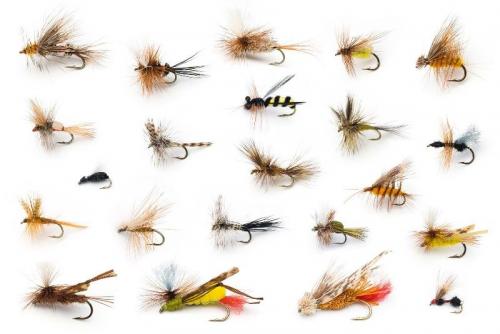Things you must know when fishing dry flies for trout
 When fishing dry flies for trout, delicacy and presentation are important factors. You can easily spook trout when they are in high waters, so avoid using splashy casts. For casting, you need a gentle, longer, and lighter casting that you can purchase from any dry fishing flies supplier near you.
When fishing dry flies for trout, delicacy and presentation are important factors. You can easily spook trout when they are in high waters, so avoid using splashy casts. For casting, you need a gentle, longer, and lighter casting that you can purchase from any dry fishing flies supplier near you. What type of rod is considered the best for dry fishing flies for trout?
When fishing in still waters, it is best to consider the lighter set that can be around 6wt or smaller. A 5wt or 4wt set is also good when distance isn’t an issue. Use a nine to ten-foot rod with “middle to tip” action. You can purchase it from a dry fishing flies wholesale supplier in soft cushioning for catching small to bigger fish with ease. The best thing is that dry flies are available in all sizes and shapes to suit any range of aquatic insects or terrestrials.
What type of fly line is needed for dry fishing flies?
Many floating dry fishing flies will suffice, as they float on the water, due to a slick coating. Usually, a standard weight forward taper is sufficient when you are dry fly fishing. You can even invest in a more specialist type of double tapered line for better, fast, and delicate presentation for rising trout.
Should you fish one or several dry flies?
Usually, one dry fly is enough but people often use two to three for extending the length of the leader while fishing. By extending the length of the leader by a few feet, you can even place some of your dries at about 20-25cm of the dropper for at least four feet apart.
How to cast dry fishing flies for trout?
Try to control the size of the loop and make it relatively larger – for about one meter or so. A larger and wider loop helps you to reduce any tangles when using a longer leader. Even get some droppers for better fishing on still water.
How to prevent your dry flies from sinking?
It actually depends on what your dry flies are actually made from. There are several floatants made from specific materials. Most dry fishing flies can be prevented from sinking by applying silicone gel. You need to squeeze a small smear and rub it onto your dry fly to keep it floating for a long time. You also need to replenish your cast every so often until you catch the fish.
For CDC dry fishing flies, you might need a powdered floatant such as Frog's Fanny. Even Amadou, a natural fungus, can be used for making it feel soft and spongy.
When you are using dry fishing flies, it is important to look for a place where fish rise the most on the water level. If you cannot see rising fish, your better chances are at the areas where terrestrial insects are seen blowing onto the shore. Just find the best spot, prepare your dry fishing fly and be patient until you catch the good trout.
Advertise on APSense
This advertising space is available.
Post Your Ad Here
Post Your Ad Here
Comments